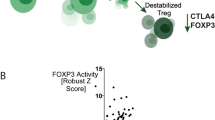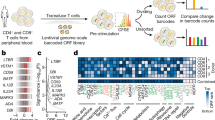Abstract
A coordinated effort combining bioinformatic tools with high-throughput cell-based screening assays was implemented to identify novel factors involved in T-cell biology. We generated a unique library of cDNAs encoding predicted secreted and transmembrane domain–containing proteins generated by analyzing the Human Genome Sciences cDNA database with a combination of two algorithms that predict signal peptides. Supernatants from mammalian cells transiently transfected with this library were incubated with primary T cells and T-cell lines in several high-throughput assays. Here we describe the discovery of a T cell factor, TIP (T cell immunomodulatory protein), which does not show any homology to proteins with known function. Treatment of primary human and murine T cells with TIP in vitro resulted in the secretion of IFN-γ, TNF-α, and IL-10, whereas in vivo TIP had a protective effect in a mouse acute graft-versus-host disease (GVHD) model. Therefore, combining functional genomics with high-throughput cell-based screening is a valuable and efficient approach to identifying immunomodulatory activities for novel proteins.
This is a preview of subscription content, access via your institution
Access options
Subscribe to this journal
Receive 12 print issues and online access
$209.00 per year
only $17.42 per issue
Buy this article
- Purchase on Springer Link
- Instant access to full article PDF
Prices may be subject to local taxes which are calculated during checkout





Similar content being viewed by others
Accession codes
References
Hertzberg, R.P. & Pope, A.J. High-throughput screening: new technology for the 21st century. Curr. Opin. Chem. Biol. 4, 445–451 (2000).
Fox, S., Farr-Jones, S. & Yund, M.A. High-throughput screening for drug discovery: continually transitioning into new technology. J. Biomol. Screen. 4, 183–186 (1999).
Eddy, S.R. Profile hidden Markov models. Bioinformatics 14, 755–763 (1998).
Nielsen, H., Engelbrecht, J., Brunak, S. & von Heijne, G. Identification of prokaryotic and eukaryotic signal peptides and prediction of their cleavage sites. Protein Eng. 10, 1–6 (1997).
Barash, S., Wei, W., & Shi, Y. Human secretory signal peptide description by hidden Markov model and generation of a strong artificial signal peptide for secreted protein expression. Biochem. Biophys. Res. Commun. 224, 835–842 (2002).
Chen, C. et al. An integral functional genomics screening program reveals novel a role for BMP-9 in glucose homeostasis. Nat. Biotechnol. 21, 294–301 (2003).
Swartzman, E.E., Miraglia, SJ., Mellentin-Michelott, J., Evangelista, L. & Yuan, P.M. Homogeneous cell- and bead-based assays for high-throughput screening using fluorometric microvolume assay technology. J. Biomol. Screen. 4, 193–204 (1999).
Gurlo, T., Huang, W.-W. & von Grafstein, H. PGE2 inhibits IL-2- and IL-4-dependent proliferation of CTLL-2 and HT2 cells. Cytokine 10, 265–274 (1998).
Latchman, Y. et al. PD-L2 is a second ligand for PD-1 and inhibits T-cell activation. Nat. Immunol. 2, 261–268 (2001).
Tseng, S.Y. et al. B7-DC, a new dendritic cell molecule with potent costimulatory properties for T cells. J. Exp. Med. 193, 839–846 (2001).
Freeman, G.J. et al. Engagement of the PD-1 immunoinhibitory receptor by a novel B7 family member leads to negative regulation of lymphocyte activation. J. Exp. Med. 192, 1027–1034 (2000).
Yang, Y.G., Dey, B.R., Sergio, J.J., Perason, D.A. & Sykes, M. Donor-derived interferon-γ is required for inhibition of acute graft-versus-host disease by interleukin 12. J. Clin. Invest. 102, 2126–2135 (1998).
Cho, C.Q., Wittmer, S. & Dalton, D.K. Failure to suppress the expansion of the activated CD4 T-cell population in interferon-γ-deficient mice leads to exacerbation of experimental autoimmune encephalomyelitis. J. Exp. Med. 192, 123–128 (2000).
Brok, H.P., Vossen, J.M. & Heidt, P.J. IFN-γ-mediated prevention of graft-versus-host-disease: pharmacodynamic studies and influence on proliferative capacity of chimeric spleen cells. Bone Marrow Transplant. 22, 1005–1010 (1998).
Holler, E. et al. Prognostic significance of increased IL-10 production in patients prior to allogeneic bone marrow transplantation. Bone Marrow Transplant. 25, 237–241 (2000).
LaFleur, D.W. et al. Interferon-κ, a novel type I interferon expressed in human keratinocytes. J. Biol. Chem. 276, 39765–39771 (2001).
Forrer, P., Tamaskovic, R. & Jaussi, R. Enzyme-linked immunosorbent assay for measurement of JNK, ERK, and p38 kinase activities. Biol. Chem. 379, 1101–1110 (1998).
Kotanides, H. & Reich, N.C. Requirement of tyrosine phosphorylation for rapid activation of DNA binding factor by IL-4. Science 262, 1265–1267 (1993).
Gleichmann, E., Pals, S.T., Rolink, A.G., Radaszkiewicz, T. & Gleichmann, H. Graft-versus-host reactions: clues to the etiopathology of a spectrum of immunological disease. Immunol. Today 5, 324–332 (1984).
Acknowledgements
The authors wish to thank Andrea Smith for assistance with the manuscript preparation.
Author information
Authors and Affiliations
Corresponding author
Ethics declarations
Competing interests
The authors declare no competing financial interests.
Supplementary information
Rights and permissions
About this article
Cite this article
Fiscella, M., Perry, J., Teng, B. et al. TIP, a T-cell factor identified using high-throughput screening increases survival in a graft-versus-host disease model. Nat Biotechnol 21, 302–307 (2003). https://doi.org/10.1038/nbt797
Received:
Accepted:
Published:
Issue Date:
DOI: https://doi.org/10.1038/nbt797
This article is cited by
-
Characterization of protein cargo of Echinococcus granulosus extracellular vesicles in drug response and its influence on immune response
Parasites & Vectors (2023)
-
GWAS and eQTL analysis identifies a SNP associated with both residual feed intake and GFRA2 expression in beef cattle
Scientific Reports (2018)
-
Comparative transcriptome profiling approach to glean virulence and immunomodulation-related genes of Fasciola hepatica
BMC Genomics (2015)
-
Systematic genome-wide screens of gene function
Nature Reviews Genetics (2004)
-
Functional genomics to new drug targets
Nature Reviews Drug Discovery (2004)



